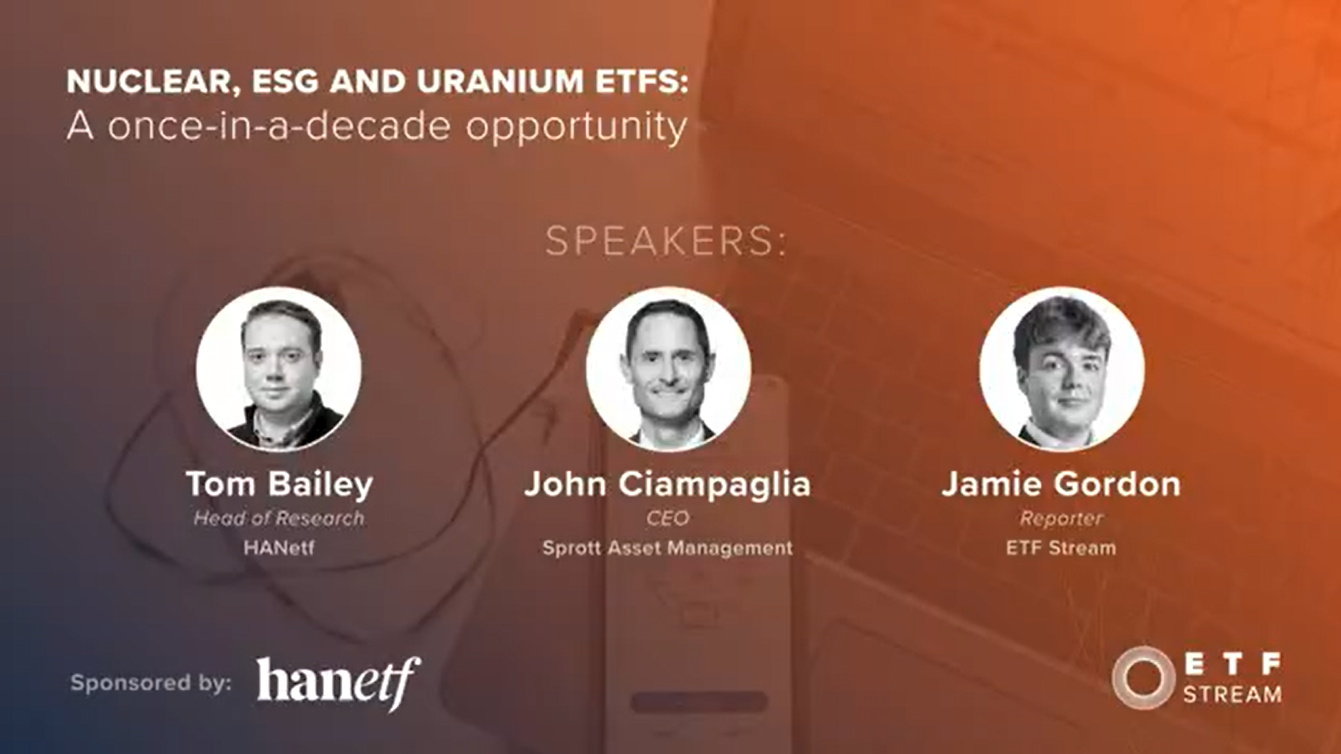The impact of rising demand for nuclear on supply, its key role in the transition to net zero and how to capture the opportunity through an ETF were all topics covered in ETF Stream’s webinar with HANetf.
The discussion, titled Nuclear, ESG and uranium ETFs: A once-in-a-decade opportunity, started by assessing how the narrative around nuclear energy has shifted over the past 12 months following several landmark geopolitical events.
John Ciampaglia, CEO and senior managing director at Sprott Asset Management, said the United Nations COP26 climate summit in Glasgow last year was the catalyst for change, becoming the point in which governments recognised the role it could play in the climate transition to net zero.
“The science and the facts behind nuclear energy are winning the day finally. Unfortunately, there was a period where nuclear had a negative halo on it, but the world is finally realising it can be part of the solution towards decarbonisation, while it has been accepted as an ESG-friendly activity,” he said.
Is nuclear ESG?
The European Union decided to include nuclear within its taxonomy activities in July while US President Joe Biden has been “hugely pro-nuclear”, both of which has opened the door for increased investment into the industry.
“The sector is now coming out of the penalty box. Governments have realised the only way they are going to keep their nuclear fleets intact is to give the industry the right incentives,” Ciampaglia said. “The taxonomy will help reduce the financing cost to upgrade their plants, extend operating life-span or build new plants.”
Despite its inclusion in the EU’s sustainable taxonomy, nuclear is still labelled ‘non-ESG’ Article 6 under the Sustainable Financial Disclosure Regulation (SFDR), however, this does not undermine the wider opportunity, particularly with the Sprott Global Uranium Miners UCTS ETF (URNM), according to Tom Bailey, head of research at HANetf.
“Maybe it will change in the future but these companies already deal with very strict regulations by being in the nuclear sector,” he said. “The focus with URNM is about the real-world environmental opportunity in terms of decarbonisation and net zero, it would be great to receive Article 8 classification but it is not the most relevant right now.”
Supply-side issues
Despite not being labelled Article 8, the growing uptake of nuclear by governments across the globe has led to a supply deficit in the industry.
“The world’s 434 nuclear reactors need 180 million pounds of uranium every year for fuel and last year, all the mines globally only produced 130 million pounds,” Ciampaglia said.
“That number will slowly go up as mines come back online but we still have a supply deficit. This is where the investment thesis comes into play,” he continued. “The only way you are going to feed these nuclear plants with more fuel is to produce more uranium which is bringing capital flows into the sector.”
He added miners are starting to bring mines back online, some of which have not been live since 2018, as the price per pound of uranium has risen to a point to make it viable.
“Now the price has risen, it gives companies an incentive and the confidence to reopen mines and sell contracts to utility companies, so they have confidence in supply longer term,” Campiaglia said.
Uranium is trading at $50 a pound, as of 21 November, however, at its peak in 2007 the price for a pound of uranium was $140.
Despite this, Campiaglia believes the price will attract mining companies to open existing mines but not open new uranium mines and expand production.
“We believe the price of uranium needs to go materially higher from where it is today to incentivise greenfield production,” he said. “It is critical these sources come online or we will have a shortage and impact our ability to produce more clean energy.”
This demand has been seen at the product level, according to Bailey. The $30.3m URNM has performed strongly since launching in April, returning over 7% in the last six months, and is HANetf’s most successful launch this year in terms of inflows.
“It is still a polarising topic in Europe and not everyone is willing to consider it but those that do are dedicated in terms of understanding the theme,” Bailey said. “We like to think of URNM as a much more pure-play approach within the market.”
URNM tracks the North Shore Sprott Uranium Miners index which targets companies that get at least 50% of their revenues from the uranium industry, alongside physical uranium.
Bailey added: “The focus on the mining sector allows us to target the theme in the most optimal way, particularly if you look at where revenue growth will be generated.”
To watch a full replay of the webinar, click here.
Related articles




